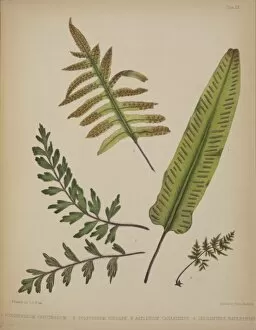Polypodium Vulgare Collection
"Discover the Timeless Beauty of Polypodium Vulgare
All Professionally Made to Order for Quick Shipping
"Discover the Timeless Beauty of Polypodium Vulgare: An Antique Botany Illustration" Step back in time with this stunning antique botany illustration featuring Polypody Fern, also known as Polypodium vulgare. Published in 1889, this chromolithograph showcases the intricate details and delicate beauty of this fascinating plant. Leonhart Fuchs, a renowned botanist, immortalized the common polypody fern in his work "De historia stirpium. " The colored engraving from 1542 captures its essence with remarkable precision. Its vibrant green fronds gracefully unfurl, creating an enchanting display that has captivated nature enthusiasts for centuries. Polypodium vulgare, commonly referred to as the common polypody or simply polypody, is a species that holds great significance in British botanical history. Anna Atkins herself was inspired by its elegance and included it in her pioneering cyanotype photographic works during the 19th century. This artwork not only showcases the aesthetic appeal but also highlights its importance within the world of plants (Cryptogamae). As part of a larger ecosystem, these ferns contribute to biodiversity and provide shelter for various organisms. The intricate patterns on each leaflet are reminiscent of lacework or delicate embroidery. These unique characteristics make Polypodium vulgare easily recognizable among other fern species. Its resilience allows it to thrive in diverse environments around the globe. Whether you appreciate vintage illustrations or have a passion for botany, this captivating image will transport you to a bygone era when scientific discoveries were made through meticulous observation and artistic interpretation. Let yourself be enchanted by the timeless allure – an exquisite representation of nature's wonders captured forever on paper.















